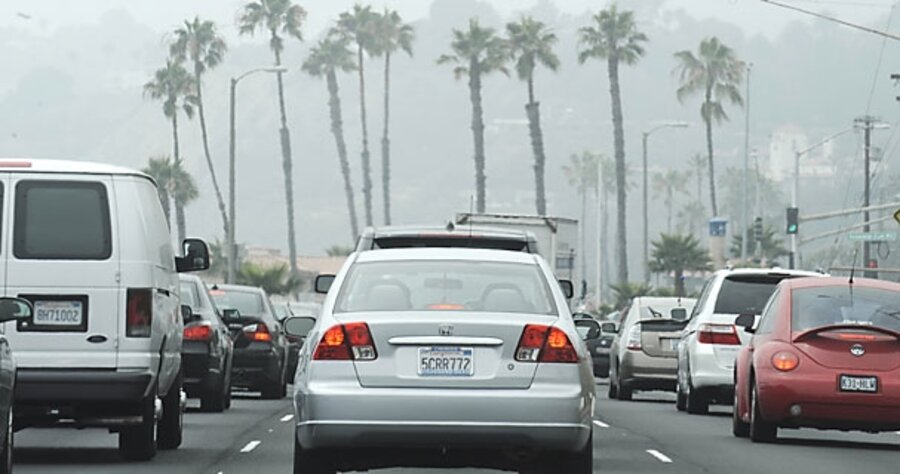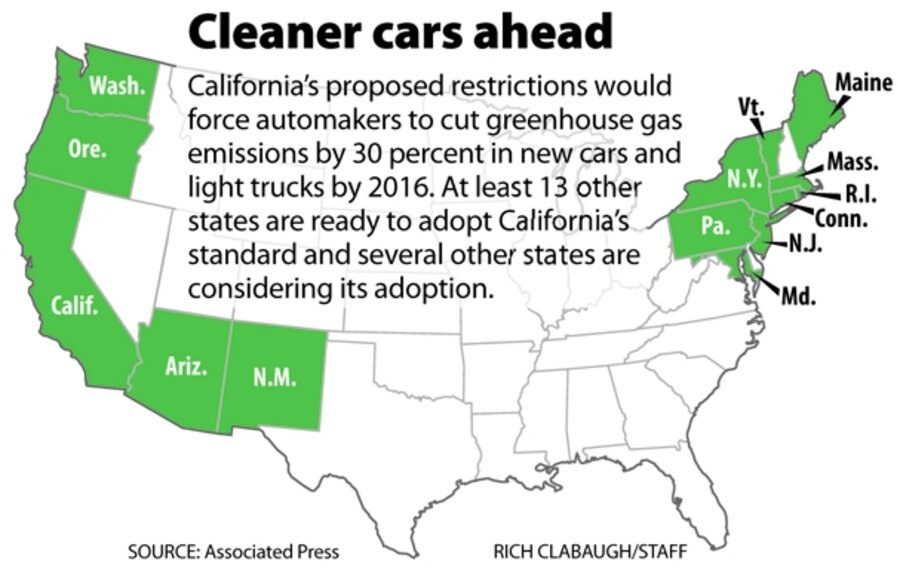Under Obama’s energy plan, cars would be cleaner but costlier
Loading...
| Boston and Los Angeles
President Obama’s first big push for US energy independence – centered on tougher fuel-efficiency standards – is likely to impose new costs on an already reeling auto industry, consumers, and probably taxpayers.
But his moves on Monday, which come amid a growing consensus that America needs to radically revamp the way it uses energy, may have an upside, too. For one, they may help Detroit drive faster down an inevitable road toward efficiency. The resulting retooling of factories, too, may have some stimulative effect on a struggling economy.
But the moves will also take an economic toll, analysts say, as consumers face higher prices for cars and as taxpayers may be asked to spend additional dollars to transform an ailing but important US industry.
Mr. Obama called for prompt implementation of federal fuel-economy standards enacted under President Bush, so that improvements kick in with the 2011 model year. Carmaker fleets are slated to rise to an average fuel economy of 35 miles per gallon by 2020. [Editor's note: The original version contained an unclear statement regarding President Obama’s position on federal fuel-economy standards. The story has been corrected to more accurately reflect his position.]
In an important reversal of Bush administration policy, he also said his administration will reconsider a waiver request by California and 13 other states to set their own standards on emissions – including greenhouse gases.
The president put the moves in a global context by pledging to work with other nations to secure the benefits that energy efficiency can bring to economies and the environment, as well as realize the advantages of reducing oil revenues to dictators and terrorists.
“The train has left the station. The debate isn’t really whether this [push for clean energy] is going to happen or not,” says Rebecca Lindland, an auto industry analyst at IHS Global Insight in Lexington, Mass. “The problem is … the financial burden that it will put on consumers. It will make vehicles more expensive.”
Obama himself cited concern that the auto industry, already in a precarious state, not be harmed by moves on behalf of energy security and the environment.
For all their avowals of interest in helping the environment, potential car buyers may not have several thousand dollars extra to spend on a more efficient vehicle, Ms. Lindland says. If sales aren’t strong, this transformation of Detroit might hobble the industry instead of saving it.
Left unsaid by Obama, for now, was anything about the size and nature of more federal help for carmakers. Two of the three big Detroit-based carmakers, General Motors and Chrysler, recently received an emergency credit line of $17.4 billion to avoid bankruptcy. So far Ford has not sought federal aid.
The loans are contingent on the carmakers coming up with plans for long-term viability by March 31, with an interim report due in February. From its inception last month, this rescue bid was seen as merely the first step toward what will likely be more federal aid.
The industry has been battered by recession and volatile fuel prices, with sales plunging from a 16-million-vehicles-per-year pace to 10 million per year in recent months.
During the presidential campaign, Obama talked of a bargain between Washington and Detroit: If automakers shifted toward a green future, he said, government would help with the big costs they face, such as healthcare for workers.
Monday’s initiatives by Obama come as Americans are still reeling from last summer’s bout with $4-a-gallon gasoline, and when momentum to take significant action on global warming is rising. Both major-party presidential candidates called for bold new policies on energy and climate change.
Presidents going back to Richard Nixon have promised to wean America from imported oil – and failed. “America has arrived at a crossroads,” Obama said Monday, and must act now even though the recession has caused oil prices to drop sharply from their 2008 highs.
The move, he said, would help pull America out of recession, as the administration’s wider push for energy efficiency would create an expected 460,000 jobs.
David Yarnold, executive director of the Environmental Defense Fund, praised Obama’s approach to the issue. “There is an emerging consensus that we need to build a new economy that creates jobs and protects our environment,” he said.
Lindland notes that last year barely more than 2 percent of all vehicles sold were energy-efficient gas-electric hybrids.
That suggests it may be optimistic to see big changes in US fleets starting in 2011 model year, as Obama outlined. Obama said it is vital “to work with, not against, states” on automotive regulation.
The Clean Air Act gives California special authority to regulate vehicle pollution because the state began regulating such pollution before the federal government got into the act.
But a federal waiver is still required; if the waiver is granted, other states can choose to adopt California’s standard or the federal one.
In 2007 the Bush administration’s Environmental Protection Agency denied California’s waiver request, gaining praise from the auto industry but touching off a storm of investigations and lawsuits from Democrats and environmental groups, who contended that the denial was based on political instead of scientific reasons.
In his executive order Monday, Obama directed the EPA to reexamine the decision. That does not yet overturn anything. But states that want their own power consider it a victory.
California estimates that by 2020, greenhouse emissions could be cut by 18 percent in the state through available engine technologies, cleaner fuels, and mitigation of air conditioning emissions, the Environmental Defense Fund says.
Material from the Associated Press was used in this story.






